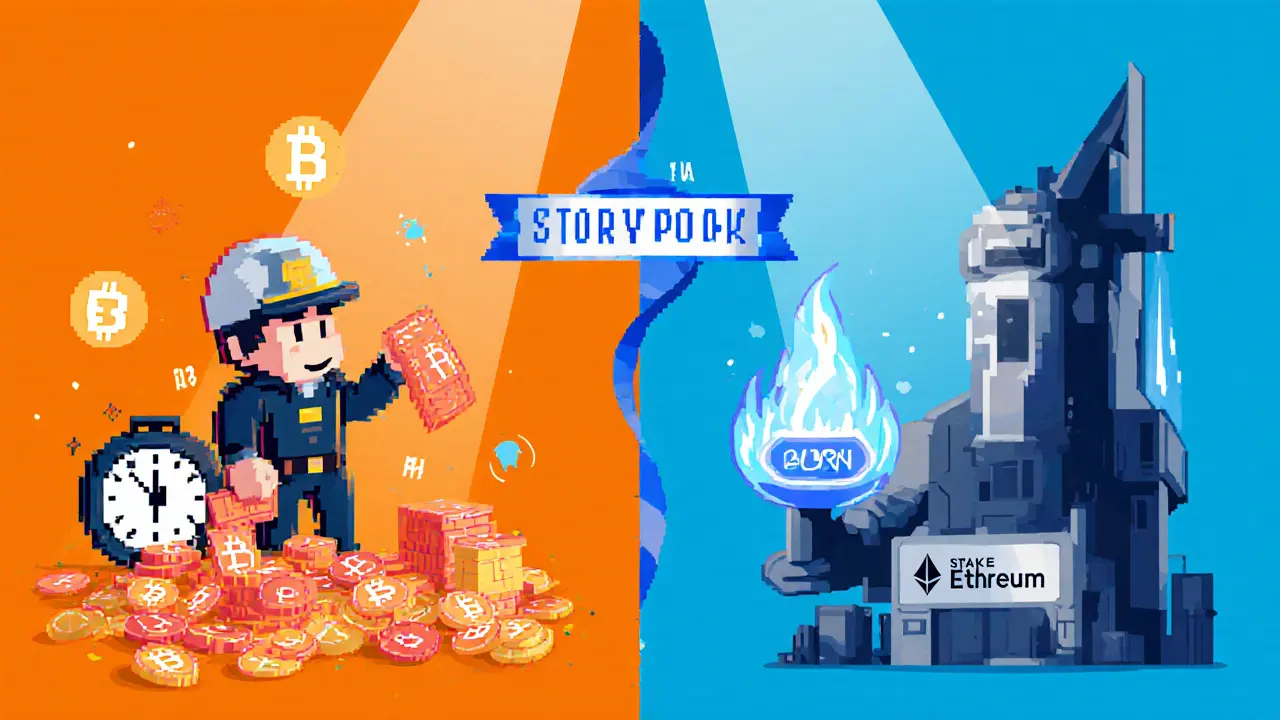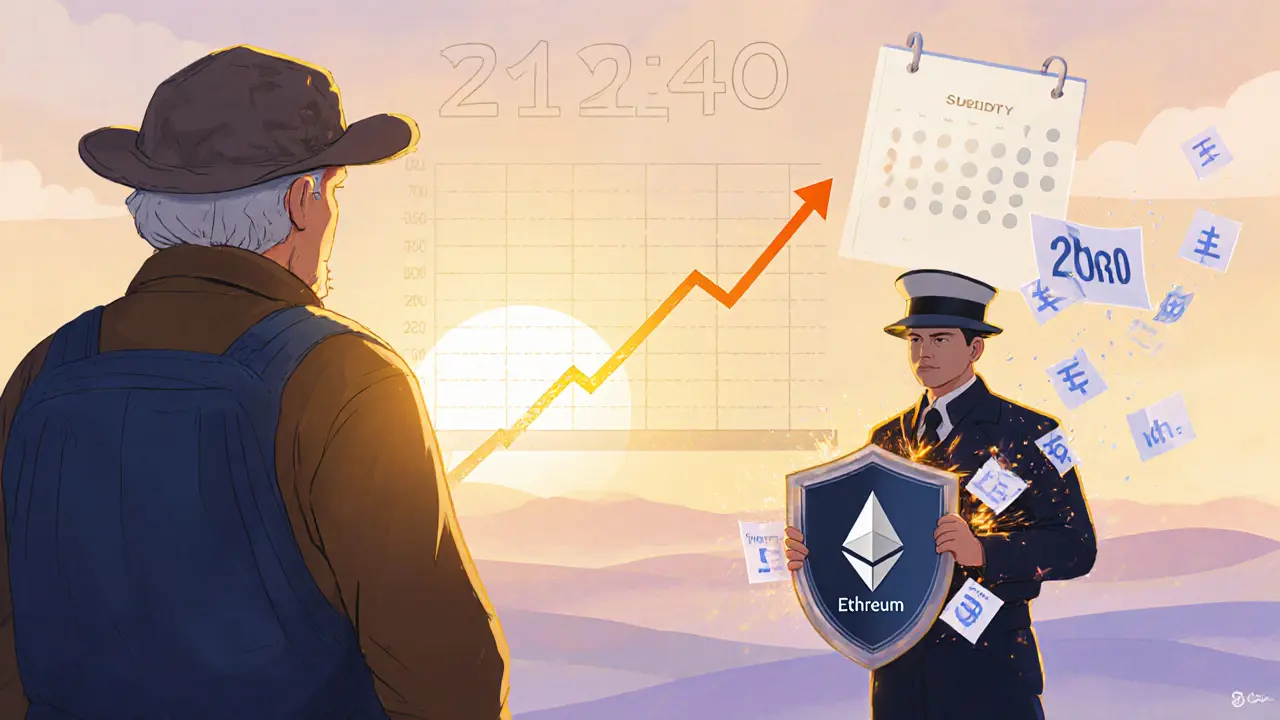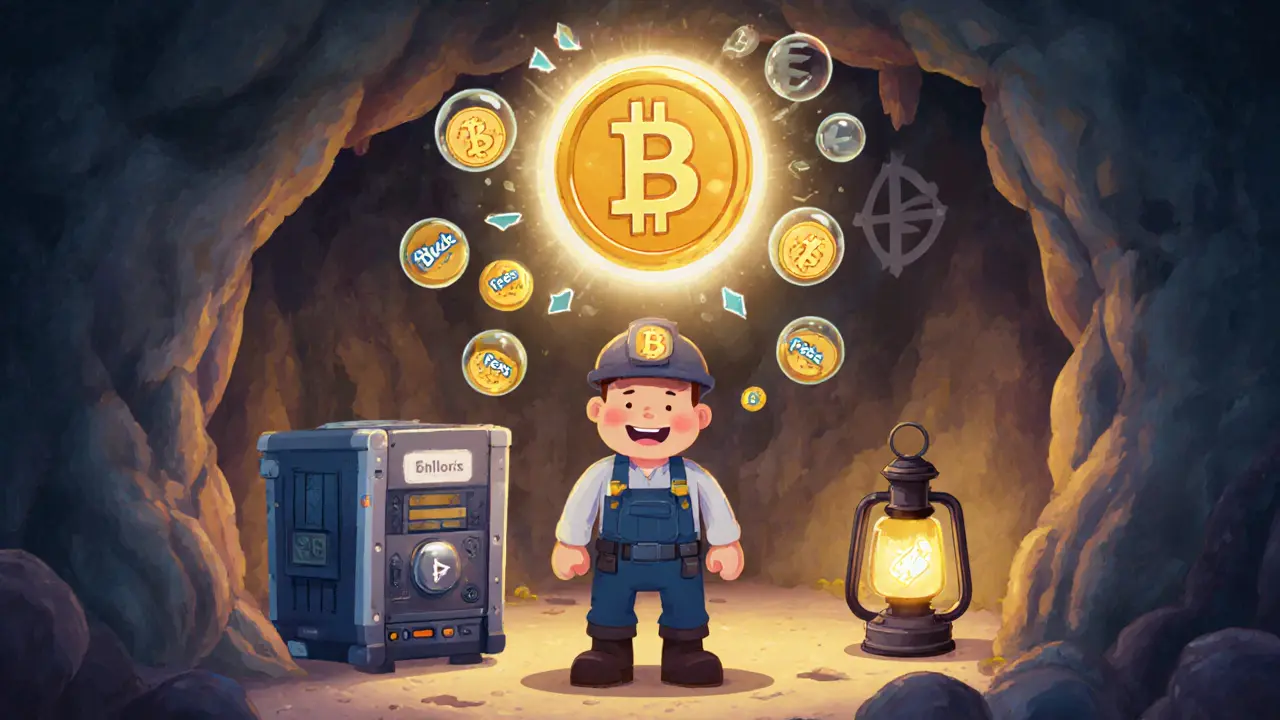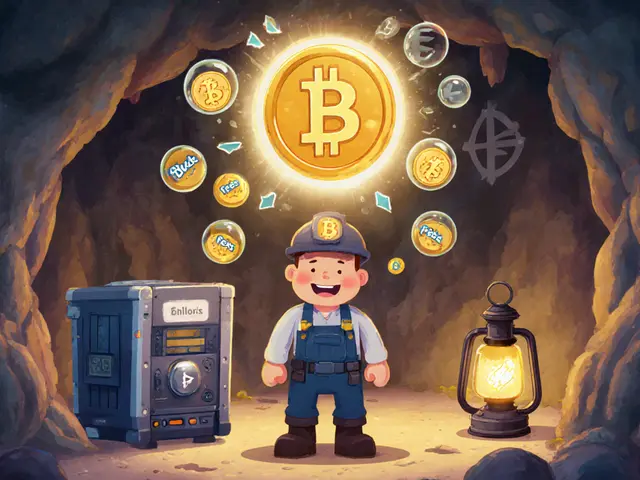Crypto Miner Income Calculator
Bitcoin Miner Inputs
Ethereum Validator Inputs
Bitcoin Daily Earnings
$0.00
(Subsidy + Fees)
Ethereum Daily Earnings
$0.00
(Staking + Fees)
Key Takeaways
- Block rewards combine newly minted coins (subsidy) and transaction fees.
- Bitcoin’s subsidy halves roughly every four years, pushing fees to the forefront.
- Ethereum’s shift to proof‑of‑stake replaces mining rewards with staking rewards and burns a portion of fees.
- When network demand spikes, fees can eclipse subsidies, reshaping miner income.
- Long‑term security depends on a sustainable fee market as subsidies dwindle.
Ever wondered why a Bitcoin miner talks about "reward" while an Ethereum validator talks about "staking"? The answer lies in how blockchain protocols pay the people who keep the network alive. This article breaks down the two sides of that payment: the block reward and the transaction fees that sit on top of it. By the end you’ll see why the balance is shifting, how it differs between Bitcoin and Ethereum, and what it means for anyone running a node, a mining rig, or a staking pool.
What Is a Block Reward?
Block Reward is a combined compensation package that includes newly minted cryptocurrency (the block subsidy) and any transaction fees attached to the block’s transactions. Satoshi Nakamoto designed it for Bitcoin to give miners a clear economic incentive to secure the network. The bonus is paid via the special “coinbase” transaction, which creates fresh coins out of thin air.
The block subsidy follows a deterministic schedule. In Bitcoin it starts at 50BTC, then halves every 210,000 blocks (about four years). This process, known as Halving, caps the total supply at 21million and steadily reduces the subsidy’s share of miner income.
Beyond Bitcoin, other chains adopt the same idea but with variations. Some, like Litecoin, halve on a different schedule; others, like newer proof‑of‑work (PoW) projects, may have a linear emission curve.
Transaction Fees Explained
Transaction Fee is a small amount of cryptocurrency that users add to a transaction to incentivize miners or validators to include it in the next block. Technically, a fee equals the difference between the sum of a transaction’s inputs and its outputs. The leftover gets claimed by the block producer.
Miners run a “fee market” - they sort pending transactions (the mempool) by fee rate (satoshis per byte for Bitcoin, gwei per gas unit for Ethereum) and pick the highest‑paying ones. During low traffic, fees are a tiny fraction of the total reward; during a surge, they can dominate.
Bitcoin fee estimation tools like mempool.space show real‑time fee rates, while Ethereum’s EIP‑1559 introduced a base fee that is burned - a concept we’ll explore later.

Bitcoin vs. Ethereum: Two Reward Philosophies
| Aspect | Bitcoin (PoW) | Ethereum (PoS) |
|---|---|---|
| Consensus | Proof-of-Work | Proof-of-Stake |
| Primary Reward | Block subsidy + transaction fees | Staking rewards + transaction fees (partial burn) |
| Subsidy Schedule | Halving every ~4years, 21M cap | No hard cap; issuance adjusts with staking rate |
| Fee Treatment | All fees go to miners | Base fee is Fee Burning, remainder to validators |
| Fee‑to‑Reward Ratio (peak periods) | Fees have reached >70% of total reward (e.g., Dec2017) | Fees can exceed staking rewards during high demand, but half is burned |
In Bitcoin, the reward is still largely subsidy‑driven, but the upcoming 2028 Halving will shrink the subsidy to 1.5625BTC, making fees even more critical. Ethereum, after its “Merge” to PoS, no longer creates new ETH via mining; instead, validators earn a proportion of newly issued ETH plus tips, while the base fee is burned, creating a built‑in deflationary pressure.
Why Fees Matter for Network Security
Both Bitcoin and Ethereum depend on economic incentives to keep attackers from taking over. As block subsidies shrink, fees become the main source of income for miners or validators. Researchers at River Financial warn that without a robust fee market, security could weaken once subsidies approach zero.
Historical data backs this up. On 22December2017, Bitcoin’s transaction fees totaled 7,268BTC - four times the subsidy amount - and accounted for 78% of the total miner revenue. That day showed a temporary flip: fees > subsidy.
In PoS systems, the security model shifts. Validators lock up capital (the stake) and earn rewards proportional to the amount staked. If fees decline, the protocol can adjust issuance rates, but the “burn‑and‑reward” balance still matters for overall token economics.
Practical Tips for Miners and Validators
- Watch the fee market. Use real‑time fee estimators to decide when to run your rigs at full throttle.
- Join a mining pool. Pools smooth out revenue streams, especially when fees are volatile.
- For Ethereum, monitor the base‑fee burn rate. High base fees mean more ETH removal, potentially boosting validator yields.
- Consider switching to PoS. With Bitcoin’s subsidy halving, some operators are diversifying into staking services.
- Stay updated on protocol upgrades. Changes to fee algorithms (e.g., EIP‑1559) can alter revenue dramatically.

Future Outlook: From Subsidy‑Dependent to Fee‑Dependent Security
By the time Bitcoin’s last subsidy is mined (around 2140), transaction fees will be the sole income for miners. The network’s survival hinges on a healthy, predictable fee market. Ethereum’s model already leans heavily on fees, but its ongoing governance discussions could tweak how much is burned vs. paid to validators.
Analysts predict that chains with high on‑chain activity (DeFi, NFTs, layer‑2 scaling) will generate enough fees to keep validators honest, while low‑usage networks may need to subsidize security through inflation or external funding.
Whether you’re a hobbyist miner, a professional pool operator, or a validator running a staking node, the key is to track two numbers closely: the block subsidy (or staking issuance) and the average fee per byte/gas unit. Those metrics tell you whether you’re earning enough to cover hardware, electricity, and opportunity costs.
Checklist: Evaluating Reward Health
- Current block subsidy amount (BTC or ETH issuance per block)
- Average fee rate over the last 24hours
- Fee‑to‑subsidy ratio (aim for >30% for future security)
- Network hash rate (PoW) or total stake (PoS)
- Upcoming protocol events (halvings, fee model upgrades)
Frequently Asked Questions
What exactly does a block reward consist of?
A block reward combines the newly created coins (the block subsidy) plus all the transaction fees from the transactions that the miner or validator includes in that block.
Why do transaction fees sometimes outweigh the subsidy?
When the network gets congested, users raise their fees to get faster confirmation. Miners select the highest‑paying transactions, so the total fee pool can surge and temporarily become larger than the fixed subsidy.
How does Ethereum’s fee‑burning mechanism work?
EIP‑1559 introduced a base fee that is calculated algorithmically each block and then permanently removed (burned) from circulation. Users also add a “tip” that goes to the validator. This reduces total ETH supply while still rewarding validators.
Will Bitcoin’s security suffer after the last halving?
Security will depend entirely on transaction fees. If the fee market stays strong-driven by active usage, layer‑2 solutions, and high‑value transfers-miners will continue to earn enough to protect the network.
Is staking on Ethereum more profitable than mining Bitcoin?
Profitability varies with ETH price, staking yield, Bitcoin price, and electricity costs. Generally, staking requires less hardware and energy, but the reward rate can be lower than Bitcoin mining during bull markets. Users should compare APRs, hardware expenses, and tax implications.







Elizabeth Mitchell
October 10, 2025 AT 08:21Chris Houser
October 10, 2025 AT 09:59William Burns
October 11, 2025 AT 00:29Ashley Cecil
October 11, 2025 AT 01:13John E Owren
October 11, 2025 AT 22:10Joseph Eckelkamp
October 12, 2025 AT 01:44Jennifer Rosada
October 12, 2025 AT 11:27adam pop
October 13, 2025 AT 10:33Dimitri Breiner
October 13, 2025 AT 22:15LeAnn Dolly-Powell
October 14, 2025 AT 04:37Anastasia Alamanou
October 14, 2025 AT 10:51Rohit Sreenath
October 14, 2025 AT 15:22Sam Kessler
October 15, 2025 AT 01:14Steve Roberts
October 15, 2025 AT 16:06John Dixon
October 16, 2025 AT 14:53Brody Dixon
October 17, 2025 AT 13:23Mike Kimberly
October 18, 2025 AT 01:55angela sastre
October 18, 2025 AT 03:42Patrick Rocillo
October 19, 2025 AT 01:05